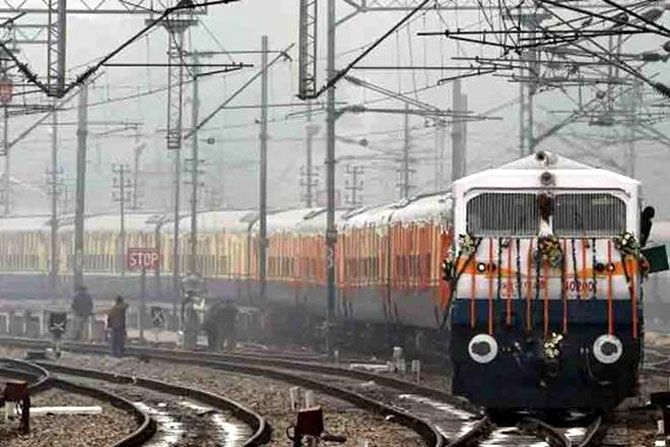 | « Back to article | Print this article |
If the finance minister meets the Board’s expectation, the next fiscal year will see the highest investment in the history of the railways. This will be up from Rs 1.33 trillion achieved in 2018-19, against the budgeted Rs 1.46 trillion.

Indian Railways is likely to see an 18 per cent increase in its capital expenditure (capex) for 2020-21, up from Rs 1.6 trillion lined up for the current financial year.
“We expect it to be Rs 1.8-1.9 trillion in the upcoming Budget. For the next 10 years, the national transporter has set a goal of increasing the capex at a compound annual growth rate (CAGR) of around 18 per cent,” said a government official.
The National Infrastructure Pipeline (NIP), recently unveiled by Finance Minister Nirmala Sitharaman, estimated the total capex in infrastructure sectors during 2020-25 at over Rs 102 trillion, of which the railways may account for 13 per cent, or Rs 13.7 trillion.
“Our focus is to make services more efficient for passengers and the freight sector, through a higher level of private sector participation,” the official said.
If the finance minister meets the Board’s expectation, the next fiscal year will see the highest investment in the history of the railways, he said. This will be up from Rs 1.33 trillion achieved in 2018-19, against the budgeted Rs 1.46 trillion.
Among the major infrastructure initiatives planned by the transporter are 100 per cent electrification and upgrading tracks, signalling, and stations to improve safety and passenger experience.
Though there has been a steady increase in capex over the past five years, a major concern for the finance department of the railways was the decline in the internal resource component of the railway capex.
It declined from 18 per cent in 2015-16 to 6.5 per cent in 2019-20. According to industry experts, reasons for this include lower growth in earnings due to issues like lesser average freight lead and increased working expenses. It was compensated through an increase in extra-budgetary resources.
Last year, the government had come out with a Rs 50 trillion investment plan in the sector till 2030. The NIP too indicated healthy private sector participation, including 30 per cent of net cargo volumes and plans to privatise 500 passenger trains in the next five years. Through the commissioning of the Eastern and Western Dedicated Freight Corridors (DFCs) and some consumer-friendly initiatives, the railways’ share in the overall freight traffic is expected to increase from around 35 per cent to 40 per cent by then.
According to the recent statistics, freight earnings during April-November FY20 saw a decline of 4.32 per cent to Rs 71,800 crore in 2019-20 compared to last year. Interestingly, passenger earnings increased 4 per cent to Rs 35,254 crore. However, a major cause for concern is its increase in working expenses by 10 per cent during the period under review, compared to the same time in 2018-19.
In its India Report 2020 released on Friday, the International Energy Agency (IEA) highlighted the advantages of the need for enhancing the role of rail in the transport sector, by 2050. An increased rail role may reduce oil demand by 3.1 million barrels per day, save around $60 billion on fuel expenditure and reduce GHG emissions by 585 Mt CO2-eq and PM 2.5 emissions by 14,000 tonnes per year, the report said.
To achieve this, the agency batted for mobilising investment to modernise the railway network, revenue generation through land value capturing, completion of high-speed rail infrastructure and phasing out the cross-subsidisation scheme (from freight rail to passenger rail) to boost the competitiveness of freight rail.
Photograph: Reuters.